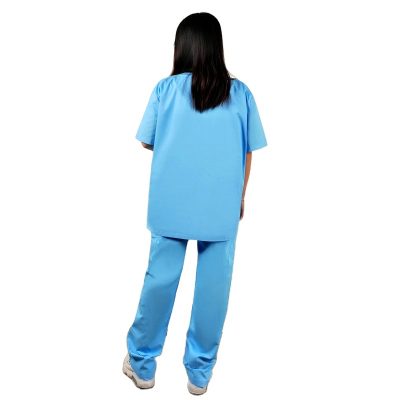The science behind scrub pants fabric involves selecting materials and weaving techniques that optimize the comfort, durability, and functionality required in healthcare settings. Here are some key aspects of the science behind scrub pants fabric:
- Breathability: Scrub pants need to be made from breathable materials to ensure comfort during long shifts. The science behind this involves selecting fabrics that allow air to flow through and moisture (sweat) to evaporate, keeping the wearer cool and dry. Cotton and certain synthetic blends are commonly used for this purpose.
- Moisture-Wicking: Fabrics with moisture-wicking properties are designed to pull moisture away from the body and onto the fabric’s surface, where it can evaporate. This is crucial for preventing discomfort and maintaining a dry feel during physically demanding tasks. Polyester, nylon, and blends with spandex often exhibit moisture-wicking capabilities.
- Durability: The durability of scrub pants fabric is essential to withstand frequent laundering and the harsh conditions of healthcare environments. The science involves selecting materials that are resistant to wear and tear, abrasion, and fading. Polyester and polyester blends are known for their durability.
- Comfort and Softness: Comfort in scrub pants fabric is achieved through the selection of soft and non-abrasive materials. The science considers the fiber composition, texture, and finishing processes to ensure that the fabric is gentle on the skin and doesn’t cause irritation.
- Stretch and Flexibility: Many modern scrub pants include stretchy materials like spandex to enhance flexibility and range of motion. The science behind this involves incorporating elastic fibers that allow the fabric to stretch and recover without losing shape or integrity.
- Antimicrobial Properties: Some scrub pants are treated with antimicrobial agents or finished with technologies that inhibit the growth of bacteria, fungi, and odor-causing microbes. This science helps maintain a hygienic environment and reduce the risk of cross-contamination.
- Resistance to Stains and Fluids: In healthcare, scrub pants need to resist stains and fluids to maintain a clean and professional appearance. The science includes using repellent treatments or fabrics with a tight weave that prevents liquids from penetrating the material.
- Color Fastness: To ensure that scrub pants retain their color and vibrancy after numerous washes, the science involves dyeing processes that bond color molecules to the fabric fibers. This minimizes fading and maintains a consistent appearance over time.
- Environmental Considerations: The science of scrub pants fabric also takes into account environmental concerns. Some manufacturers are using sustainable materials, eco-friendly dyeing processes, and responsible production methods to reduce the environmental impact of their products.
- Regulatory Compliance: Fabrics used in healthcare settings must often meet specific regulatory standards, such as flame resistance or infection control requirements. The science behind scrub pants fabric may involve incorporating these elements into the material.
Manufacturers continually research and innovate to improve the science behind scrub pants fabric. They work to strike a balance between comfort, functionality, and durability while addressing the unique needs of healthcare professionals in diverse clinical settings. Additionally, advancements in textile technology and sustainable practices contribute to the ongoing evolution of scrub pants fabric.























